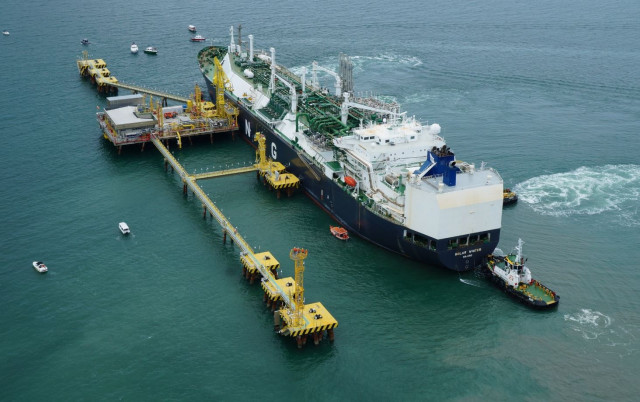Growing gas demand can be tackled by building storages in Pakistan
First few storage projects may be undertaken by major state-owned gas producers

LNG Terminal. PHOTO: REUTERS
Gas market in Pakistan is growing with the introduction of liquefied natural gas (LNG) and is expected to double in the next five to seven years at 8 billion cubic feet per day (bcfd).
In a market this size, consisting of both local production as well as imports, the issue of gas storage becomes important. LNG imports under the ‘take or pay’ contract have further enhanced the need for building gas storages in Pakistan. While local production can vary according to demand, imported LNG has to be consumed as per contractual conditions from exporting companies and countries.
Decline in natural product research becomes concern
However, under the current market liquidity, it may be possible to negotiate more lenient and flexible gas scheduling conditions. Khyber-Pakhtunkhwa government has recently complained that the province had to suffer what it terms heavy losses due to reduction in the production of oil and gas necessitated due to the advent of LNG.
The gas problem can be handled by building storages while oil problem can be handled by installing conversion facilities in the country’s large refineries. It may be appropriate here to point out that a greater role be assigned to spot purchases in order not to have constraints created by the ‘take or pay’ contracts usually found in long-term LNG contracts.
If new long-term contracts are negotiated, it should have flexible delivery conditions, otherwise, spot arrangements are to be preferred in case LNG suppliers are not ready to enter into such contracts.
Storages around the world
Gas can be stored in three types of reservoirs underground and another as LNG in steel tanks, underground or above ground. The three are depleted gas fields, water aquifers and salt caverns.
All have different characteristics and have been employed by major gas producer and consumer countries. Depleted gas field types are most popular almost everywhere where all infrastructure like gas facilities and pipelines are usually available and only renovation and incremental facilities have to be installed. Salt caverns, if available, are employed near markets.
There are 400 gas storages in the US in 31 states with storage of 8.4 trillion cubic feet (tcf). Bulk of these storages has been built in depleted gas fields. Total gas storage in Europe is 2.730 tcf, 59% of which is accounted for by three countries (France, Germany and Italy). In France, most of the storage is of aquifers’ type at a depth of 400-1,400 metres. Most storages are in the range of 7-20 billion cubic feet (bcf) and only one is of a large size of 132 bcf.
In Italy, all storage is in depleted gas fields with a total capacity of 528 bcf covering 21% of annual demand.
In Spain also, depleted gas fields are most popular, although other types are also there. Total storage capacity is 256 bcf covering 14-20% of annual demand.
In central Europe, in Poland, Bulgaria, Romania, etc, there are depleted gas field storages with total capacity of 79 bcf.
In Pakistan, all possible types can be built theoretically speaking as all the three resource types are there. There are depleted salt mines in Khewra which is close to markets also. There are many depleted gas fields as well.
At a conservative rate of 10% of annual demand, a storage capacity of 150 bcf would be required. If one storage is of 10 bcf, 10-15 storages would be required initially at various depleted gas sites. An investment of $50-75 million would be required per site on the average.
'Gas theft harming financial base'
A few FSUs (floating storage units) could also be considered. Old LNG shops or FSRUs could be utilised for these purposes. These could be permanently moored alongside a jetty or an equivalent arrangement.
An FSU may cost half of the FSRU. However, compared to the aforementioned options like gas fields type, it would be many more times expensive. Unless there is technical necessity, such storage may not be advisable.
Ultimate economies of storage depend on the type of usage and storage in terms of cycling. A day-to-night or weekly or biweekly cycling injection and evacuation can have a different revenue cycle than a seasonal storage.
This would create a scope for IPP-type investment. A policy may be prepared for gas storage and floated for the consideration and input from stakeholders.
A feasibility study had been done earlier in 2004-2007 on the subject which may have to be revised keeping in view the new circumstances created by LNG.
First few storage projects may be undertaken by major gas producers in the public sector such as OGDC and PPL.
The writer is a former member energy of the Planning Commission
Published in The Express Tribune, April 2nd, 2018.
Like Business on Facebook, follow @TribuneBiz on Twitter to stay informed and join in the conversation.



















COMMENTS
Comments are moderated and generally will be posted if they are on-topic and not abusive.
For more information, please see our Comments FAQ